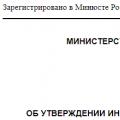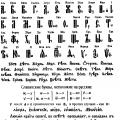The main document confirming the working period and professional achievements is considered to be a special book regulated by the Labor Code of the Russian Federation. Applying for a job using a work book always involves indicating information about the citizen’s education (in the form of secondary, specialized or higher education).
Legal basis for registering a book
For institutions, organizations and private entrepreneurs, the Labor Code of the Russian Federation (Article 65) and by-laws (listed below) determine the mandatory execution by the employer of records for recording and maintaining the period of professional activity of the employee, including the necessary information about the employee being hired.
All information, together with data about education, is determined by the established procedure for making entries in the employment document, based on:
- Regulations No. 225 dated April 16, 2003 (Resolution of the Cabinet of Ministers of the Russian Federation);
- special Instructions for filling out No. 69 dated 10.10. 2003 (Resolution issued by the Russian Ministry of Labor).
The work book is issued no later than 7 days from the date of acceptance of the employment application. It is filled out in the presence of a citizen (clause 8 of the Rules).
Information about employed persons is indicated on the title pages of the books (clause 9 of the Rules).
The personnel employee indicates all the necessary truthful information about the citizen being employed in full (Article 65 of the Labor Code of the Russian Federation). It is unacceptable to shorten or replace document data (clause 9 of the Rules). The basis for the information is a passport or any document with identification (military ID, international passport, driver’s license).
The title page of the work book displays information about the education received, qualifications for the certificate or diploma provided (Law No. 273-FZ and its explanations).
Making records about education
Registration of a first-time employed citizen for a specific position assumes that the personnel records inspector will make appropriate entries about education in the work book, if the person has a supporting document (diploma, certificate of completion of courses, certificate).
Any level of higher education (bachelor, specialist, master) indicated in the diploma is transferred as data to the title part of the labor document (Law No. 273-FZ).
Registration takes place with the following information indicated (Article 65 of the Labor Code of the Russian Federation):
- Education (secondary, special, higher).
- Profession (for example: doctor, manager, lawyer).
- Specialty (“General Medicine”, “Human Resources Management”, “Law”).
Read also Each vacancy must be reported to the employment service.
The wording indicated in the certificate and diploma is transferred to the front of the book, regardless of the time of their issuance at the time of the legislation in force at that time (clause 2.1 of the Instructions).
Capital entries in the work book about the change in education indicate the facts: ongoing studies (show a student card), as well as increased qualifications (certificates of completion of courses, university diplomas).
All entries in the work book must be carefully filled out using a black (blue) pen. The date, month and year are written only in Arabic numerals (clause 1.1 of the Instructions).
An approximate example of the design of a title page line about education in a work book and the changes made is presented below:
The same example of filling out documentation in an employment document is used as a sample for correcting educational information.
They do not record an increase in qualification level after completing the courses and passing the exam. This data is entered into the internal part of the labor report.
If the person being employed does not have any education other than secondary education, then this data is indicated based on the school certificate.
The owner of the work record, in the presence of a personnel employee, is obliged to check all the information entered and, if formatted correctly, secure it with a personal signature. The HR inspector also endorses the document.
Changes about education
The right to record changes in the employee’s educational level has the right to the personnel records manager at the last place of employment, in accordance with supporting documents.
If the education line was filled out incorrectly, and this error was detected in a timely manner, the document must be destroyed and a new one created (clause 42 of the Rules). If an erroneous entry is discovered late, it is recommended to make a change to the education line in the work book in the following order (clause 2.3 of the Instructions):
- Cross out the incorrect information and write the correct information next to it.
- Reflect the necessary details of the document that give the right to make corrections, with the obligatory signature of an authorized person.
From September 1, 2013 Federal Law No. 273-FZ of December 29, 2012 “On Education in the Russian Federation” came into force, on the basis of which new levels of education (the so-called educational qualifications) were introduced for citizens of the Russian Federation.
According to the new law, the following levels of education are defined:
|
What does it mean |
|
| Primary general education |
The employee graduated from three or four classes of a general education organization (high school) and did not study again or did not complete his studies until the end of the 9th grade (with an 11-year school education system) or the 8th grade (with a 10-year school education system) |
| Basic general education |
The employee graduated from 9 classes of a general education organization (secondary school) (with an 11-year school system) or 8 classes (with a 10-year school system) and received a certificate |
| Secondary general education |
The employee graduated from high school, gymnasium or lyceum (grades 11 or 10) and received a certificate |
|
The employee graduated from a professional educational organization (vocational school, vocational lyceum) and received a diploma |
|
|
The employee graduated from a professional educational organization (secondary specialized educational institution - technical school, college, school) and received a diploma |
|
| Higher education - bachelor's degree Higher education - specialty or master's degree |
The employee graduated from an educational organization of higher education (institute, university or academy) and received a diploma |
| Higher education – training of highly qualified personnel under programs for training scientific and pedagogical personnel in postgraduate (adjunct) studies, residency programs, and assistantship-internship programs |
The employee completed residency, postgraduate, postgraduate or doctoral studies and received the corresponding diploma |
Please note that in addition to changing the names of education levels, the new list does not include such types of education as “primary vocational” and “incomplete higher education”.
Article 108 of the above-mentioned Law “On Education” establishes identity (correspondence) between the levels of education that existed before 09/01/2013. (see table below). This was necessary to ensure a transition period with the entry into force of the new law. In particular, these clarifications of Article 108 are interesting and useful for personnel officers, since they have to draw up personnel documents (work books, personal T-2 cards), which indicate the level of education of the employee and his specialty.
| Primary (general) education | Primary general education |
| Basic (general) education | Basic general education |
| Secondary (complete) general education | Secondary general education |
| Primary vocational education | Secondary vocational education in training programs for skilled workers (employees) |
| Secondary vocational education | Secondary vocational education in training programs for mid-level specialists |
| Higher professional education - bachelor's degree | Higher education - bachelor's degree |
| Higher professional education - specialist training or master's degree | Higher education - specialty or master's degree |
| Postgraduate professional education in graduate school (adjunct) | Higher education - training of highly qualified personnel according to programs for training scientific and pedagogical personnel in graduate school (postgraduate studies) |
| Postgraduate professional education in residency | Higher education - training of highly qualified personnel in residency programs |
| Postgraduate professional education in the form of assistantship-internship | Higher education - training of highly qualified personnel under assistantship-internship programs |
Many personnel officers who have studied Federal Law No. 273-FZ have a question: how can we now make entries in work books and personal T-2 cards?
For those employees who received education documents after 2013, everything is clear - we are indicating a new type of education, which will be reflected in the diploma in accordance with the Education Law No. 273-FZ.
But the majority of workers still have “old” diplomas in their hands and it is these that are presented to personnel officers when hiring. How to resolve this situation? What to include in the documents? On the one hand, there are new types of education and a new legislative act, on the other hand, there are standards establishing requirements for filling out work books and the unified T-2 form.
So, in particular, paragraph 9 of the Decree of the Government of the Russian Federation dated April 16, 2003 N 225 “On work books” establishes that “... information about education, profession, specialty is entered into the work book - on the basis of documents on education, qualifications or the presence of special knowledge...”.
The “Instructions for filling out work books” (approved by Resolution of the Ministry of Labor of the Russian Federation dated October 10, 2003 N 69) also states that “...recording of education (basic general, secondary general, primary vocational, secondary vocational, higher vocational and postgraduate vocational) is carried out only on the basis of properly certified documents (certificate, certificate, diploma, etc.);...".
And in the unified T-2 form (which many continue to use without change), “old” names are listed in the corresponding column as possible options for indicating the level of education.
Thus, the wording that is contained in educational documents (certificates, licenses, certificates, diplomas) should be transferred to work books and T-2. Representatives of the Ministry of Labor of the Russian Federation share the same opinion. Thus, Deputy Head of the Federal Service for Labor and Employment Shklovets I.I. said: “If an employee brought you a diploma received before the reform of the education system, then you write in the work book the level of education that is indicated in the diploma (for example, “higher”, “primary vocational”), even if this level of education has already been abolished.” .
Since 2014, education documents have been issued using new forms and no longer indicate the specialty, but use the following wording: “Maria Ivanovna Ivanova was awarded the qualification (degree) “Bachelor” in the field of study “Psychology.” Since the forms of work record books have not changed, data on higher education should be reflected taking into account the entries in the new diplomas in this way. In the “Education” column, indicate the level of education reflecting the qualifications assigned. If a bachelor – then “higher – bachelor’s degree”, if a master – “higher – master’s degree”, if a specialist – “higher – specialist”. In the “Profession, specialty” column, indicate the direction in which it was received, for example, “Direction of training “Psychology””.
On the main page of the work book, among other data, they enter information about the employee’s education, as well as the acquired specialty. The peculiarity is that they can be supplemented after graduation from new educational institutions. In addition, information is recorded differently, depending on the level of training. Instructions for filling out 2019 and practical examples can be found in the article.
The basic principles of making entries in the labor record are described in the relevant Resolution of the Ministry of Labor and Social Development.


In accordance with the provisions of this document, registration is carried out on the basis of the following rules:
- The wording of the name of the education received must exactly correspond to that given in the diploma.
- The name of higher education is given in accordance with its level (bachelor's, master's, postgraduate or specialty).
- If, as a result of amendments to legislation, the name of the education changes, no other notes should be made in the labor report. Notes are recorded only after the fact; the law does not have retroactive effect.
- Data is entered only on the basis of submitted documents or copies certified by an organization or notary. Recording information from the employee’s words is unacceptable.
- Amendments and crossing out inscriptions are also not allowed. The exception is cases of making incorrect entries - the corresponding example is discussed in detail below.
The first entry is made by the first employer, to whom the employee brings a blank work book form. If the previous company for some reason did not fill out the column, the subsequent employer independently makes a mark. The formulation is made in accordance with the level of education, which is confirmed by documents.

If initially the personnel specialist indicated only the word “higher” in the column, it is enough to simply enter the corresponding word without correcting the entry.

As already mentioned, no additional adjustments are subsequently necessary in connection with changes in legislation in the field of education.


Salomatov Sergey
Real estate expert
The employer is not obliged to check a diploma or certificate that confirms the employee’s level of education. It is enough to receive the original or a certified copy of the document, from which you need to copy the necessary data.
Making second and subsequent entries
Subsequently, the employee can receive 2, 3 and other educations - for example, secondary vocational education after basic education or higher education after secondary general education, etc. The employer is also obliged to make the appropriate notes in the document, but the employee must independently bring a certificate or diploma, since the company is not obliged to check information about increasing the level of education.
To make a new note, you just need to put a comma in front of the old entry and enter the next information in accordance with the rules described above.

At the same time, the employee can receive further education - then you need to go to the next page (with job data) and enter the relevant information. Registration is carried out according to the following rules:
- Enter the entry number (in chronological order) and the date of entry (based on completion).
- Then in the main column you need to enter information about the education received - in what period, in what educational institution (full name), in what program, what specialty received.
- The last column indicates the name, series and number, date of issue of the document that confirms the described fact.

Previously, it was practiced to make notes about completed education on the page to the left of the title page (in fact, on the cover of the work paper). The stamp and signature of the personnel specialist were affixed. At the moment, this method of registration is not used, although it is not considered a gross error.

It is important to understand that entering such information is strictly necessary only in cases where the employee’s work requires the availability of appropriate education. Therefore, in other situations, data is indicated only at the request of the employee - their absence is not a violation.
Profession entry
This line is filled in only if the corresponding information is available in educational documents. If there is no such data, the line remains empty, which is not a violation of the law.

In other cases, the line is filled in with information from the relevant documents:
- diploma of secondary vocational or higher education;
- diploma confirming professional retraining;
- certificate of worker's profession;
- another document confirming the fact of mastering a specialty/profession.

Salomatov Sergey
Real estate expert
If a personnel specialist confuses the name of the employee’s qualification and specialty (data from the diploma), there is no need to correct the error, since it is not considered a gross violation.

Correcting an incorrect entry
If an incorrect entry has already been made, it must be carefully crossed out with a pen of the same color. After this, a record of the correction is made on the page on the left (on the cover of the work book). The basis for the correction is also indicated - data from the education document. A stamp is affixed, the position and full name are written down, as well as the signature of the employee who made the corrections.

Hiring an employee with incomplete education is an ordinary phenomenon, but an employee of the personnel department may quite naturally have questions. As such, there are no rules for filling out a work book for incomplete secondary education. After all, according to the Instructions for filling out these documents, an entry is made in the education column of the work record book if there are supporting official documents.
In addition, the Instructions provide examples of possible entries in the education column:
- 9 classes (basic))
- 11 classes (secondary))
- lyceum (primary vocational education))
- college, technical school (secondary vocational education))
- institute, academy, higher school (higher vocational education))
- postgraduate professional education.
From this it is clear that the Instruction provides for the inclusion of only completed stages of training. In case of incomplete secondary education, according to the Rules for filling out work books, you should enter the entry “basic”, that is, 9 classes, again with supporting documents, for example, a certificate from school.
Another question and more correct: is it necessary to write anything at all to an employee who has not even graduated from high school yet? After all, if education is incomplete, then the employee continues training. After the required amount of time, the employee will receive a general secondary education, which will be confirmed by a certificate. This data should be entered in the column of the title page of the work book, since this is the only completed stage of the employee’s education, and it must be indicated in the work book.
An employee with incomplete higher education
If an employee with an incomplete higher education is hired, the HR employee should distinguish between incomplete and incomplete higher education.
In the case of incomplete higher education, we are talking about a student who continues to study at a university. Incomplete higher education is already a degree of education, confirmed by a diploma, awarded to students who have completed part (at least two full-time courses) of a training program in their specialty.
When filling out a work permit for an employee who has an incomplete higher education, “incomplete higher professional education” should be entered in the education column with reference to a diploma, which will indicate that the employee has the knowledge and skills necessary to perform his job duties.
Correctly filling out the work book of an employee who continues to study and at the time of employment has an incomplete higher education is not so clear and has two options:
- the employee entered university immediately after school)
- The employee entered university after technical school.
In the first case, the employee does not have completed professional education, which, according to the Instructions, must be indicated in the work book.
Of course, you can write “incomplete higher professional education,” but this should not be done unless absolutely necessary. After some time, the employee will graduate from the university, and it will be necessary to make a record of higher professional education in his work book, but on the title page there is only one line for information about education, and it will already be occupied.
It is wiser not to rush to fill out the line about education and add to it, even if not at the time of filling out the work book, but later, a record of complete higher professional education.
The second case requires a completely different approach. The employee received some level of professional education before entering the university. In this case, information about his professional education must be reflected in the work book, because this indicates that the employee has the professional knowledge and skills necessary to perform his work.
Consequently, in the second case, there can be no discrepancies regarding the question of how to fill out a work book if an employee with completed professional education continues to study at a university and has incomplete higher education.
Upon graduation from the university and completion of higher education, this information will be entered by the personnel service employee into the employee’s work book in full accordance with the Instructions as an addition to the entry made earlier.
An HR employee must be attentive to various situations and nuances when filling out a work book and make a decision about the need or advisability of an entry, based on the Instructions, Rules and common sense.




